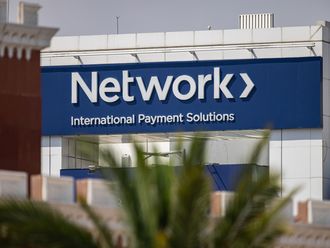MADRID
Strong underlying profit growth at Banco Santander in 2016 and a better-than-expected performance in the last quarter drove its shares higher on Wednesday as it weathered the impact of falls in the pound and the Mexican peso.
The Eurozone’s largest bank by market value kicked off Spain’s bank reporting season with a 4 per cent rise in 2016 net profit to 6.2 billion euros (Dh24.43 billion; $6.65 billion) as results in Brazil improved for the fourth quarter in a row.
Santander’s shares rose 4.5 per cent to a 17-month high and were at the top of Spain’s blue-chip Ibex index. They have outperformed Europe’s STOXX banking index over the past year with a 8.3 per cent rise.
Fourth quarter net profit was 1.6 billion euros, compared to 25 million euros a year earlier when Santander was hit by a 600-million-euro mis-selling compensation bill in Britain.
An average of analyst forecasts calculated by Reuters was for a 2016 profit of 6.1 billion euros, while analysts said the bank’s fourth quarter results were 9 per cent ahead of consensus.
Santander said business in its largest market Brazil helped it through a squeeze on margins in Europe that is pressuring its peers, as well as softening the impact of currency devaluations.
“Stripping out the effect of the currency depreciation in the UK we have seen a recovery in profit and the market is welcoming that performance,” Nuria Alvarez, an analyst at Madrid-based brokerage Renta 4, said.
In Britain, its second largest market, Santander’s 2016 profit was down almost 15 per cent over the year, mainly due to the fall in sterling, which has sunk to a near three-decade low since Britons voted to leave the European Union in June.
A slide in the peso to a historic low virtually meant net profit rose by just 0.1 per cent in Mexico, which accounts for 8 per cent of Santander’s total profit, whereas it would have been up 17.5 per cent without currency fluctuations.
However, net profit in Brazil rose for the fourth quarter in a row and net interest income for the third consecutive quarter after a deep recession there caused returns to tumble last year.
Santander’s executive chairman Ana Botin said she expected a volatile year ahead but that business would be stronger than in 2016 in key markets and she saw opportunities for profitable growth.
“In 2016, we have been able to offset a lot of the unexpected adverse conditions from Brexit, to lower than anticipated rates, higher taxes and some others,” Botin told analysts on a conference call.
For 2016, Santander’s total net interest income, a measure of earnings on loans minus deposit costs, was 31.1 billion euros, down 3.4 per cent from a year ago, mirroring pressure on margins experienced by other Spanish banks. Analysts had expected NII to come in around 30.8 billion euros.
But unlike most other Spanish banks, Santander will not be hit by a European court ruling that may force them to reimburse up to 4 billion euros to mortgage customers.
Santander reaffirmed its 2018 targets such as boosting its fully-loaded core capital ratio, a closely watched measure of a bank’s strength, to just above 11 per cent, after it ended the year with a ratio of 10.55 per cent.
— Reuters












